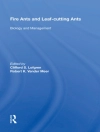This book comprehensively examines the complex relationship between forests and climate change from a biological perspective. It explores the effects of climate change, such as rising temperatures, greenhouse gas emissions, changing rainfall patterns, droughts, and cold spells, on individual trees and forest ecosystems. It considers how climate change affects forest structure, function, composition, and biodiversity, and the adaptive strategies forests employ to cope with changing conditions.
The book focuses on understanding the adaptive capacity of forests and explores different mechanisms at stand and ecosystem levels that enable forests to respond to changing climatic conditions. It discusses how forests acclimate and adapt to new climates by modulating growth rates, morphology, phenology, physiology, biochemistry, and species composition. The role of genetic diversity and evolutionary processes in shaping forest resilience and adaptation is also explored. The book also explores potential mitigation strategies to reduce the impacts of climate change. Besides, this book discusses the ecological principles and the involvement of local communities in conservation and restoration efforts as alternative strategies to enhance the resilience of forest ecosystems against climate change.
The book provides practical recommendations for policy makers, forest managers, and conservation practitioners to develop effective climate change adaptation and mitigation strategies in forest landscapes. This book serves as a valuable resource and a guide for researchers, students, and professionals in various fields to protect and sustainably manage vital ecosystems in a rapidly changing climate.
قائمة المحتويات
Chapter 1. Understanding the Interplay between Forests and Climate Change.-Chapter 2. Species Distribution and Range Shifts, Species composition.-Chapter 3. Shifts in phenology and climate change interaction.-Chapter 4. Morphological and Physiological Changes in Response to climate change.-Chapter 5. Alteration in Biochemical and Molecular Expression.-Chapter 6. Forest biodiversity, ecosystem functioning, and Resilience.-Chapter 7. Plant Functional Traits Response and Role in governing ecosystem functioning.-Chapter 8. Insect pest incidences and forest health.-Chapter 9. Pollinators and reproductive biology.-Chapter 10. Forest growth and development.-Chapter 11. Wildfire fire and fuel availability, including fire severity.-Chapter 12. Change in the flow of ecosystem services.-Chapter 13. Nutrients cycling.-Chapter 14. Community dynamics.-Chapter 15. Resources availability and their distribution.-Chapter 16. Microbial biomass and activity.-Chapter 17. Litter fall patterns and its degradation process and mineralization.-Chapter 18. Biological Insights into Forest Adaptation to Climate Change: Ecosystem Resilience and Adaptation.-Chapter 19. Mechanisms of natural adaptation in forests, including genetic variation, phenotypic plasticity, and species migration.-Chapter 20. Adaption mechanisms at phenological and morphological level.-Chapter 21. Adaption mechanisms at biochemical and molecular levels.-Chapter 22. Adaptive forest management strategies to enhance Resilience and facilitate adaptation.-Chapter 23. Incorporation of ecological interactions and functional traits in adaptive management approaches.-Chapter 24. Restoring forest habitats and promoting habitat restoration.-Chapter 25. Soil and water conservation practices.-Chapter 26. Concept and Significance of Climate Smart Forestry or Climate Resilient Forestry.- Chapter 27. Forests and agroforestry as a mitigation tool or nature-based solution to mitigate climate change impacts.-Chapter 28. Carbon sequestration potential of forests and forest soils and their role in climate change mitigation.-Chapter 29. Sustainable forest management practices to enhance carbon storage and reduce greenhouse gas emissions.-Chapter 30. Forest-based renewable energy and sustainable utilization of forest resources for climate change mitigation.-Chapter 31. REDD+ activities.- Chapter 32. The importance of conserving existing forest areas and protecting biodiversity.-Chapter 33. Restoration approaches to rehabilitate degraded or deforested lands.-Chapter 34. Integrating Climate change considerations into conservation and restoration Efforts.-Chapter 35. Examination of specific case studies highlighting successful biological insights, adaptation measures, and mitigation strategies in forest ecosystems.-Chapter 36. Lessons learned and best practices for effective climate change response in forests.-Chapter 37. The significance of long-term monitoring programs in assessing the impacts of climate change on forests.-Chapter 38. Research advancements and methodologies for studying biological responses to climate change.-Chapter 39. Climate change detection methodologies, including paleoclimatology particularly dendroclimatology.-Chapter 40. Bridging the gap between scientific research and practical application in forest management and conservation.-Chapter 41. Research Gaps: Identifying future research directions and the need for continued action in addressing climate change impacts on forests.
عن المؤلف
Hukum Singh is a forest physiology and climate change scientist associated with the Forest Research Institute in Dehradun, India. His research covers eco-physiology, plant responses to abiotic stresses, green technology, climate change adaptation and mitigation, urban forestry, and more.












